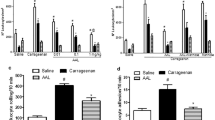Summary
The influence of counter irritation by turpentine (0.2 ml) on zymosan-and carrageenan-oedemas was investigated in the rat. Zymosan-oedema was inhibited by mepyramine and methysergide and by leucopenia. It was not modified by captopril and developed normally in kininogendeficient Brown Norway rats. Leucocytes and mast cell amines but not kinins are thus involved in zymosan-oedema. The last phase of this reaction was inhibited by counter irritation alone, but the odema was largely depressed by counter irritation in rats pretreated with mepyramine and methysergide.
Carrageenan-oedema was increased by kininase inhibitors and inhibited by leucopenia in normal rats. This inflammatory reaction had a small developement and was not increased by kininase inhibitors in kininogen-deficient BN rats. Leucocytes and kinins participate in the developement of this inflammatory reaction in normal rats while kinins are lacking in deficient rats. Counter irritation depressed carrageenan-oedema in deficient Brown Norway rats and suppressed the potentiating effect of kininase inhibitors in normal rats. Carrageenan oedema was nearly abolished in turpentine-treated leucopenic rats.
These results suggest that the anti-inflammatory effect of counter irritation by turpentine could depend on a reduction of leucocyte accumulation into zymosan-oedema and on a reduction of both kinin formation and of leucocyte accumulation into carrageenan-oedema. The significance of T-kininogen as acute phase reactant is discussed.
Similar content being viewed by others
References
Baldo BA (1982) Inflammation, counter irritation and rat serum acute phase α2-macroglobulin levels. Agents and Actions 12:333–339
Borges DR, Gordon AH (1976) Kininogen and kininogenase synthesis by the liver of normal and injured rats. J Pharm Pharmac 28:44–48
Boura ALA, Svolmanis AP (1984) Converting enzyme inhibition in the rat by captopril is accompanied by potentiation of carrageenan-induced inflammation. Br J Pharmac 82:3–8
Cole T, Inglis AS, Roxburgh CM, Howlett GJ, Schreiber G (1985) Major acute phase alpha-protein of the rat is homologous to bovine kininogen and contains the sequence for bradykinin: its synthesis is regulated at the mRNA level. FEBS Letters 182:57–61
Damas J, Adam A, (1985) Congenital deficiency in plasma kallikrein and kininogen in the Brown Norway rat. Experientia 36:586–587
Damas J, Adam A (1985) The relationship between kallikreins and kininogens in Brown Norway deficient rat plasma. Mol Physiol 8:307–316
Damas J, Deflandre E (1984) The mechanism of the anti-inflammatory effect of turpentine in the rat. Naunyn-Schmiedeberg's Arch Pharmacol 327:143–147
Damas J, Remacle-Volon G (1986) Mast cell amines and the oedemas induced by zymosan and carrageenans in rats. European J Pharmacol (in press)
Damas J, Remacle-Volon G, Adam A (1984) The role of the kinin system in various inflammatory models in the rat. Int J Tissue Reactions 6:391–399
Deflandre E, Damas J, Adam A (1983) Prostaglandin biosynthesis is not affected by the anti-inflammatory effect of turpentine. Prostaglandins Leuko Med 12:179–188
Di Rosa M, Giroud JP, Willoughby DA (1971) Studies of the mediators of the acute inflammatory response induced in rats in different sites by carrageenan and turpentine. J Pathol 104:15–29
Gemmell DK, Cottney J, Lewis AJ (1979) Comparative effect of drugs on four paw oedema models in the rat. Agents and Actions 9:107–116
Greenbaum LM (1984) T-kinin and T-kininogen-Children of new technology. Biochem Pharmacol 33:2943–2944
Hayashi I, Ino T, Kato H, Iwanaga S, Nakano T, Oh-ishi S (1984) Demonstration of the third kininogen in high and low molecular weight kininogens-deficient Brown Norway Katholiek rat. Thromb Res 36:509–516
Higgs GA (1984) The effects of lipoxygenase inhibitors in anaphylactic and inflammatory responses in vivo. Prostaglandins Leuko Med 13:89–92
Konno S, Tsurufuji S (1983) Induction of zymosan-air-pouch inflammation in rats and its characterization with reference to the effects of anticomplementary and anti-inflammatory agents. Br J Pharmac 80:269–277
Kushner I (1982) The phenomenon of the acute phase response. Ann NY Acad Sci 389:39–48
Limaos EA, Borges DR, Souza-Pinto JC, Gordon AH, Prado JL (1981) Acute turpentine inflammation and kinin release in ratpaw thermic oedema. Br J exp Path 62:591–594
Ohkubo I, Kurachi K, Takasawa T, Shiokawa H, Sasaki M (1984) Isolation of a human cDNA for alpha-2-thiol proteinase inhibitor and its identity with low molecular weight kininogen. Biochemistry 23:5691–5697
Perlik F, Willoughby DA, Giroud JP (1977) Studies of some inflammatory and immunological responses of different strains of rat. Biomedicine 26:336–343
Schorlemmer HU, Bitter-Suermann D, Allison AS (1977) Complement activation by the alternative pathway and macrophage enzyme secretion in the pathogenesis of chronic inflammation. Immunology 32:929–940
Schwartz HJ, Kellermeyer RW (1969) Activation of Hageman factor by carrageenan and its possible significance. Proc Soc Exp Biol Med 132:1021–1024
Timsit J, Aminot A, Lechat P (1980) Influence of some irritating or immunostimulating substances on experimental pleurisy in the rat. Arch Int Pharmacodyn 245:166–176
Vallée E, Gougat J, Navarro J, Delahayes JF (1979) Anti-inflammatory and platelet anti-aggregant activities of phospholipase A inhibitors. J Pharm Pharmac 31:588–592
Vane JR (1971) Inhibition of prostaglandin synthesis as a mechanism of action for aspirin-like drugs. Nature 231:232–235
Vinegar R, Truax JF, Selph JL (1976) Quantitative studies of the pathway to acute carrageenan inflammation. Fed Proc 35: 2447–2456
Warvas M, Osada J (1985) Changes of the level of proteinase inhibitors in rat plasma during turpentine-induced inflammation. Experientia 41:633–634
Wedmore CV, Williams TJ (1981) Control of vascular permeability by polymorphonuclear leukocytes in inflammation. Nature 289:646–650
Author information
Authors and Affiliations
Rights and permissions
About this article
Cite this article
Damas, J., Remacle-Volon, G. & Deflandre, E. Further studies of the mechanism of counter irritation by turpentine. Naunyn-Schmiedeberg's Arch. Pharmacol. 332, 196–200 (1986). https://doi.org/10.1007/BF00511412
Received:
Accepted:
Issue Date:
DOI: https://doi.org/10.1007/BF00511412




